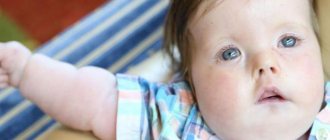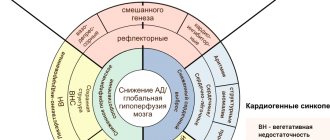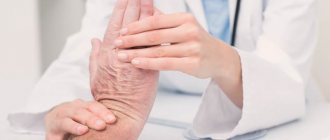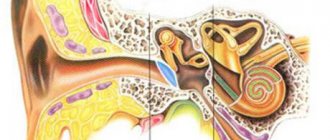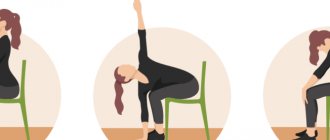Tremor in newborn babies is manifested mainly by twitching of the chin and upper limbs. It can be considered a similar manifestation of muscle hypertonicity, which is the main sign of an immature nervous system of a baby. Tremor in infants manifests itself mainly due to overexcitability of the nervous system when the baby screams, cries, and also when he wants to eat, or someone frightened him. Parents may also notice that their child's eyeballs move during sleep. This usually occurs during a phase of sleep called REM sleep.
Tremor in newborns is not a rare phenomenon; it occurs in almost 50% of all children born. From the first day of life until 4 months, signs of tremor are considered normal, but if they do not disappear after this period, then you need to take a closer look at the baby. It may be worth consulting a doctor at this point. But if the hands and chin have not stopped shaking even after a year, then this is a clear signal about problems with the child’s health. To understand when tremor is a benign specific condition of the nervous system, and when it is a serious problem, we suggest that you read this article.
The children's nervous system lends itself well to “regulation”. Therefore, the sooner you notice the problem and receive qualified help, the greater the chances of normalizing the state of the central nervous system and restoring it.
What is most affected by involuntary shaking in children?
If you look at the statistics, you can make an unambiguous conclusion - often almost all babies have head tremors. This is what indicates the incomplete maturity of the baby’s nervous system. When a baby's arms or legs, as well as lips and chin, shake, this is already a consequence of prematurity.
Parents should also understand that such phenomena do not occur in every child. Therefore, you should not immediately panic while waiting for your baby.
Characteristics of physiological tremor in infants
Spontaneous muscle shaking is called tremor. Most often, newborns experience trembling of the chin, lips, upper and lower extremities. Increased muscle tone and immaturity of the peripheral nervous system lead to convulsive contractions.
Pathological tremor is diagnosed if muscle spasms intensify and spread to other parts of the body.
Serious disorders of the nervous system lead to pathological tremor. Nervous stress can cause severe crying or fear, which leads to muscle tremors. Most often, the provoking factor leads to trembling of the lower jaw, lips, arms or legs.
Characteristics of physiological tremor:
- Quick disappearance of tremors;
- Complete disappearance upon reaching three months of age.
Critical moments to pay attention to occur at one, three, nine and twelve months of the child. It is at this time that parents should pay special attention to the child’s condition and regularly show him to a neurologist. Pathological tremor leads to the fact that the child becomes nervous, overly excitable, capricious, and his appetite and sleep are disturbed.
Tremor in children: main causes
As mentioned above, the culprit may be the immaturity of the nervous system. But other factors, such as premature birth and fetal hypoxia, can also lead to trembling.
The child's immature nervous system
After birth, children do not yet have developed coordination of movements, and their nervous system has not reached the required stage of maturity. This is what most often causes chin tremor in infants, as well as trembling of the limbs. A violent outburst of emotions, which increases the level of norepinephrine in the body, also contributes to the appearance of trembling of the baby’s arms and legs. Increases the chances of developing this phenomenon and muscle hypertonicity.
Fetal hypoxia
Fetal hypoxia, which can develop both in utero and at the time of birth, has become a fairly common problem. Lack of oxygen, especially long-term, negatively affects brain function. A number of factors contribute to the development of hypoxia:
- Disorders of the functional activity of the placenta.
- An infection that developed in utero.
- Increased tone of the uterus when the mother is threatened with miscarriage.
- Bleeding during pregnancy.
- Polyhydramnios.
All these factors limit the supply of oxygen to all cells of the body, including the brain, which also affects the development of the nervous system. In addition, oxygen starvation can be caused by the characteristics of labor (rapid labor and weak contractions), entanglement of the fetus in the umbilical cord, and placental abruption.
Premature birth
Chin tremor in newborns born prematurely also occurs due to the immaturity of the nervous system, since the baby was deprived of continued intrauterine development. Therefore, the central nervous system of a premature baby continues to form outside of the baby’s presence in the womb, and these can hardly be called optimal conditions for this process. No matter how attentively and carefully the mother treats the baby, she is not able to provide him with the atmosphere that was in her stomach. Therefore, we can safely say that limb tremors in children in any case depend on the maturity of the nervous system.
Why does limb tremors occur in newborns?
Tremor is a compensatory response of immature nerve endings that leads to muscle cramps. Tremor is divided into physiological and pathological. The first type of tremor is characterized by small amplitude and rhythm. Most often it causes trembling of the child's lower lip and chin.
With physiological tremor, trembling may be asymmetrical or symmetrical.
This type of tremor goes away quite quickly. Most often it is caused by excessive nervous tension in the baby, for example, after bathing, prolonged crying or during intestinal colic. Symptoms of tremor are most common in premature babies.
Causes of pathological tremor:
- Immature nerve centers of the brain;
- Improper functioning of the endocrine system;
- High norepinephrine content.
Pathological tremor can occur due to hypoxia, stressful situations, threat of miscarriage, rapid labor, umbilical cord entanglement, placental abruption, and birth injuries. Dr. Komarovsky believes that physiological tremor should not cause concern for parents. But continuing symptoms in children over the age of one year should alert you and be a reason to visit a neurologist.
Targeted treatment and its necessity
Based on the data available to doctors, we can say that the concern is caused by tremor that persists for 4 months. In this case, the shaking spreads to the baby’s legs and head, and the mother knows for sure that the baby is not shaking at certain moments (hunger, fear, etc.). Parents should understand that such a phenomenon may be a warning sign of the following problems:
- Hypomagnesemia.
- Increased blood sugar levels.
- Intracranial hemorrhage.
- Drug withdrawal or withdrawal syndrome.
- Hypoxia-ischemia of the brain.
- Increased intracranial pressure.
- Low calcium levels in the blood.
- Sepsis.
In these cases, the doctor will definitely prescribe you a full examination and appropriate treatment.
When to see a doctor
Medical attention is required for children with trembling of the chin and other parts of the body if the culprits of the tremor are diseases of the central and peripheral nervous system. The mother needs to carefully observe the child, even make notes about the time and cause of the chin trembling.
To understand what nature the tremor has (physiological or pathological), answer 5 questions based on observations of the baby:
- Child's age? Tremor up to 3-4 months is not diagnosed as a disease. You should consult a doctor after this age, if you regularly observe a pathological symptom, an increase in the number of causeless tremors and their intensity.
- How long does the tremor last? If the shaking is intense, lasts more than 30 seconds, the symptom repeats daily, the baby needs the help of a specialist.
- What's trembling? If in the first months of life only the chin shakes from stress, while other parts of the face and limbs remain calm, parents should not be nervous. Closer to the year, the unpleasant symptom for mom will pass. If a two-month-old baby shakes his entire head, chin and limbs at the same time, you should not postpone a visit to the doctor.
- Is there a reason for chin trembling? Anxiety should be caused by tremor at rest, for no apparent reason (fright, crying, hunger, bathing, etc.). If the tremors have provoking factors, the attack does not last long and is repeated less frequently with age, the help of a pediatrician will not be required.
- Is trembling accompanied by other signs of illness? Contact a neurologist or pediatrician if, during tremors, the baby's facial skin turns blue and becomes covered with perspiration, twitching begins immediately after feedings, tremors of the head and limbs are asymmetrical, and the baby has large tremors.
In this video, you will learn even more about chin tremors from your pediatrician.
What is the treatment
If a child’s arms, legs or head are shaking, then treatment should be aimed not only at restoring the state of the nervous system, but also at health in general. That is why the mother must strictly follow the neurologist’s instructions and adhere to all recommendations. Most often, medications such as Glycine, Asparkam, etc. are prescribed. But only a pediatric neurologist can identify the exact cause of trembling limbs and prescribe medications. Therefore, self-medication is dangerous.
But the procedures that are necessarily prescribed for children suffering from tremors are simply necessary. First of all, this is massage, gymnastics and swimming.
What if your chin and legs tremble?
The famous pediatrician and teledoctor Evgeniy Olegovich Komarovsky is often asked what to do if a baby’s chin is shaking and an arm or leg is connected to the tremor? The pediatrician advises not to worry if the baby otherwise behaves normally: sleeps well, eats, smiles, and develops correctly in basic indicators.
It is impossible to make a diagnosis based on one symptom - irregular tremor of parts of the body or face - in a young child.
To suspect a pathology, more compelling reasons and regular manifestations of symptoms of the disease are required.
If you do not observe other signs of central nervous system diseases, except for tremor from fear or joy, and the neurologist has prescribed medication, consult another doctor. If trembling of the lips, chin, or limbs is combined with other clinical symptoms of neurological pathologies, appears at rest, and does not disappear after 4–6 months, you should not hesitate to seek medical help.
Massage treatments for tremors
At home, giving a baby a massage is quite simple, and any mother can handle it. The main thing is to combine massage with constant conversations with the baby. The main movements of massage include kneading, stroking, rubbing and vibration. Usually the doctor himself gives an example of how you should do a massage. But you can also watch a special video below.
In the meantime, I would like to say that during the session your baby should feel as comfortable as possible, because all your actions are aimed specifically at strengthening the child’s nervous system. Therefore, it is worth remembering some rules:
- Ventilate the room well.
- Before the massage, be sure to remove your rings and bracelets so as not to scratch your baby. It is also a good idea to cut your nails.
- Rub your palms together and knead your hands.
- Massage should be done only when the child is active and in a good mood.
- If during the process the child’s mood worsens, then stop the session. The baby should calm down and become cheerful again.
- Do not bring your baby to the clinic for a massage. It’s better to hire a massage therapist and introduce him to the child so that he can get used to a stranger. Ideally, it is better to do the massage yourself in an atmosphere familiar to the baby.
- Nothing should irritate the child. It is better to eliminate loud music, bright lights and other external factors before the massage session.
- Be sociable and affectionate with your child. Songs, rhymes and funny jokes are the best accompaniments to any procedure.
- Do a massage half an hour before water treatments. This way you can provide your baby with even more “relaxation”.
Swimming and gymnastics
If you have not yet decided to send your baby to infant swimming, then you can carry out water procedures at home. If a child has tremors of the limbs, then it will be extremely useful for him to swim, even while in your arms. Let the baby have plenty of play with his hands and feet, and let the water in the bathroom be at the most comfortable temperature.
Gymnastics for a baby is also useful. There are a number of exercises that you can also do with your baby at home.
- Grab your baby's foot with one hand and tap the outside of his leg with the other. This exercise is called the “hammer” and is repeated on both legs alternately.
- Stroke your baby's arms and legs. Take the baby by the hand and, shaking it slightly, lower yourself from the shoulder to the wrist. This exercise should be performed on the legs and arms alternately.
- Stretch your baby's buttocks. To do this, place the baby on his tummy and just lightly tap his butt with your little fists.
Remember that tremors are a completely natural phenomenon and should not cause you to panic. But you must monitor your baby daily. Children under one year old continue to develop, so you need to not miss the moment when you, together with a specialist, can make any adjustments. Doctors note several critical periods in a baby’s life. These are 1, 3, 9 and 12 months. It is at this time that the nerve endings become very sensitive, and any deviation can cause pathologies. Therefore, the future health of your baby depends on your attention and participation.

